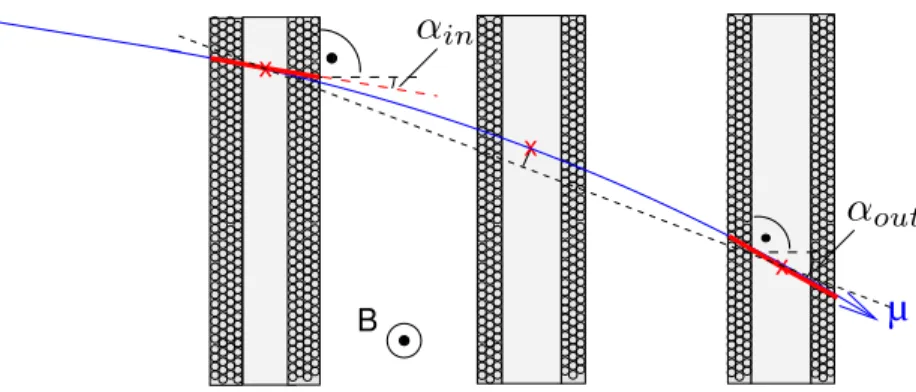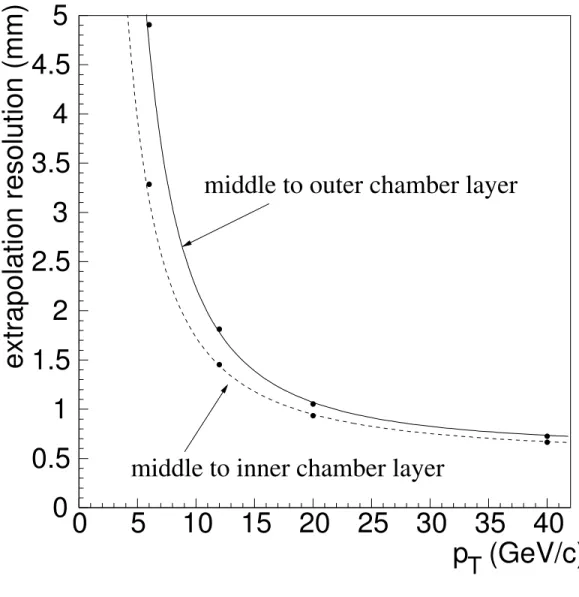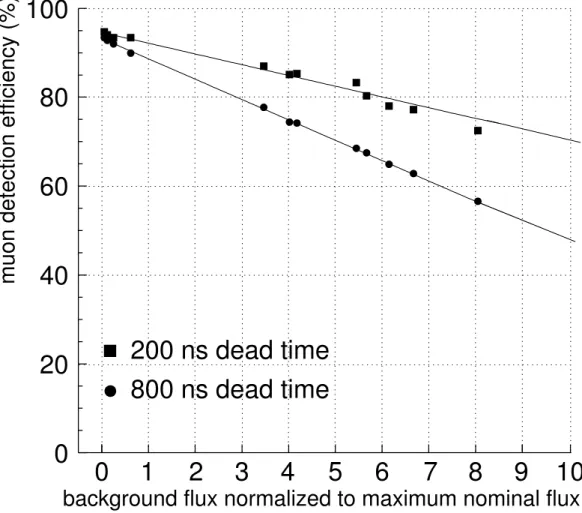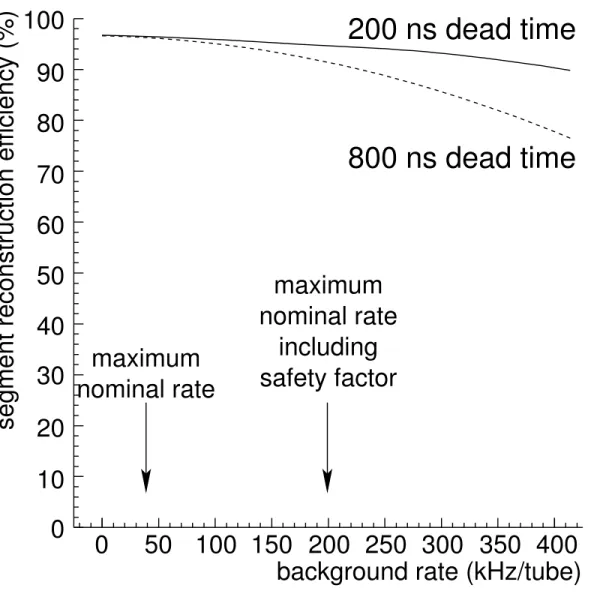Alignment of the ATLAS Muon Spectrometer with Tracks and Muon Identification at High
Background Rates
Oliver Kortner a , Hubert Kroha a , Jens Schmaler a , Chrysostomos Valderanis a
a Max-Planck-Institut f¨ ur Physik, F¨ ohringer Ring 6, D-80805 M¨ unchen, Germany
Abstract
The ATLAS muon spectrometer consists of three layers of precision drift-tube chambers in an average toroidal magnetic field of 0.4 T. Muon tracks are recon- structed with 97% efficiency and a momentum resolution of better than 10% for transverse momenta up to 1 TeV/c. The latter requires misalignment corrections of the track curvature with an accuracy of about 30 µm which are provided by an optical alignment monitoring system. A method has been developed to measure relative chambers positions with curved muon tracks with comparable precision in order to increase the redundancy of the alignment system.
During the operation of the LHC at its design luminosity of 10 34 cm − 2 s − 1 , the muon chambers will be exposed to a high flux of neutrons and γ rays which may lead to occupancies of up to 16%. Based on test-beam data taken at the Gamma- Irradiation Facility at CERN, we show that the anticipated reconstruction efficiency can be achieved with the precision chambers in this environment and how it can be sustained at even higher background rates which are expected for a possible luminosity upgrade of the LHC.
1 Introduction
The ATLAS muon spectrometer consists of three layers of muon chambers
operated in an air-core toroid magnet system with an average field strength of
0.4 T and 3 Tm bending power. The high stand-alone momentum resolution of
better than 10% up to muon energies of 1 TeV requires muon detectors with
high spatial resolution and precise monitoring of the relative alignment of
the chambers [1]. The precision muon chambers, monitored drift-tube (MDT)
chambers, are built out of two triple or quadruple layers of pressurized drift
tubes with 80 µm spatial resolution. As the anode wires of the tubes are
positioned with 20 µm accuracy within a chamber, the chambers provide a track-point measurement with an accuracy of 40 µm. A system of optical sensors measures the relative chamber positions with an accuracy of 30 µm.
In the first part of this note, we present a method which uses curved muon tracks to determine relative chambers positions with a comparable precision as the optical alignment system.
During the operation of the experiment, the muon chambers will be exposed to a high flux of neutrons and γ rays leading to occupancies of up to 16%.
Test-beam measurements with an ATLAS MDT chamber at the Gamma Irra- diation Facility (GIF) at CERN [2] showed that the detection efficiency of the drift tubes used with standard operating parameters deteriorates significantly at high background rates. In the second part of the note, we show how the de- tection efficiency of the drift tubes can be improved in order to maintain muon reconstruction efficiencies greater than 97% event at the highest background rates expected at the LHC.
2 Alignment of the ATLAS muon spectrometer with tracks
Muons traversing the muon spectrometer leave to good approximation straight track segments in each chamber layer. The track segments are used to deter- mine an average track point at the centre of each chamber (see Fig. 1). The sagitta of the muon track in the magnetic field, i.e. the shortest distance of the track point in the middle layer from the straight line connecting the track points in the inner and outer layer, is a measure of the muon momentum. In the barrel part of the spectrometer, the track sagitta is approximately given by s ≈ 500 µm/p[GeV/c] where p is the muon momentum. The track points are measured with 40 µm accuracy resulting in a sagitta resolution of better than 50 µm and a muon momentum resolution of better than 10% for p T ≤ 1 Tev/c.
The track sagitta gives the most precise determination of the muon momen- tum, but is very sensitive to misalignments of the three chamber layers. The misalignment corrections to the muon sagitta are, therefore, measured with 30 µm precision by the optical alignment system [1]. The optical alignment system will be calibrated with straight muon tracks while the magnetic field is turned off. Here we study the feasibility of using curved muon tracks to determine the misalignment corrections with comparable accuracy in order to provide additional redundacy. A momentum determination independent of the sagitta measurement is needed for this purpose.
This is not provided with sufficient accuracy by the track measurements in
the inner detector because of energy loss fluctuations in the calorimeters. But
one can make use of the fact that each MDT chamber measures the directions
of the muon trajectories, the track segments, in addition to the average track points (cf. Fig. 1). The momenta of low-energy muons with p T < 40 GeV/c can be determined with a resolution of about 2% by comparing the track di- rections in the inner and outer layer of the muon spectrometer. The deflection angle ∆α = α out − α in in the magnetic field is independent of the relative horizontal shifts. So it can be used to obtain the muon momentum which is needed to extrapolate the muon track from the middle chamber layer to the outer chamber layers and compare the extrapolated with the measured track positions. The misalignment of the outer layers with respect to middle is equal to the deviation of the extrapolation from the measured track points.
We applied our method to fully simulated single-muon Monte-Carlo data sets.
Fig. 2 shows the resolution of the extrapolation of a single track segment from the middle to the outer chamber layers as a function of the transverse muon momentum. The resolution is dominated by multiple scattering in the muon spectrometer and therefore improves with increasing momentum. It ap- proaches a minimum value of about 1 mm at p T = 20 GeV/c. This indicates that, in order to achieve an alignment accuracy of the order of 30 µm, the position measurements of at least 1,000 muon tracks have to be combined.
The momentum measurement using the deflection angle, however, is suffi- ciently accurate only, if the relative rotation of the outer and inner chamber layers around the tube axis is known to better than 0.01 mrad. It can be measured with the required accuracy using 50,000 muon tracks of 6 GeV/c transverse momentum where the momentum has to be determined by yet an- other measurement which is independent of the relative displacements of the chamber layers. The latter is obtained with a statical precision of about 20%
for 6 GeV/c muons from the curvature of the muon trajectories whithin the middle chamber layer.
In order to explore the systematic limitations of our new alignment algorithm, an ensemble test of the algorithm was performed on fully simulated single- muon Monte-Carlo data with the correct detector geometry. The test showed that an alignment accuracy of 100 µm is achieved, if 50,000 muon tracks of 6 GeV/c are used to determine the rotation of the outer and inner chamber layers around the tube axis. Additional 1,000 tracks of 20 GeV/c allowed us to measure the relative displacements of the chamber layers with an accuracy of about 400 µm. 10,000 tracks of 20 GeV/c were needed to achieve an alignment accuracy of 100 µm.
In the experiment, the required muon tracks per chamber tower can be ob-
tained from the planned single-muon data stream of 2.5 kHz rate within 3
hours data taking at the LHC for the initial luminosity fo 10 33 cm − 2 s − 1 .
3 Muon reconstruction at high rates
Monte-Carlo calculations [3] predict nominal counting rates of up to 40 kHz (60 kHz) per tube in six (eight) layer chambers. The predicted background rates have a large uncertainty such that up to 5 times higher background rates may be encountered in ATLAS at the LHC design luminosity of 10 34 cm − 2 s − 1 . At these high rates, muon hits in a tube can be masked by background hits.
Previous studies therefore show a significant decrease in the muon detection efficiency of single tubes with increasing background rates (see Fig. 3). The efficiency drop can be minimized by operating the read-out electronics with its minimum adjustable dead time of 200 ns instead of its default value of 800 ns.
The default value of 800 ns, which is of the same size as the maximum drift time, has been chosen in order to avoid multiple hits from afterpulses. The cited studies, however, report a 2 times smaller hit multiplicity than originally expected from simulation such that the operation at a short dead time becomes feasible.
Previous investigations [2][4] also showed that, in a six-layer chamber, a seg- ment reconstruction efficiency ≥ 97% at the nominal background rates can be achieved with ≤ 0.1 fake segments per event. At a couting rate of 200 kHz per tube (five times the maximum nominal rate), the efficiency drops to 90%
if the number of fake segments is kept below 0.25 per muon trigger. The effi- ciency can be almost recuperated at the price of accepting 3.5 fake segments per muon trigger. The operation at a low dead time could, however, provide a way to increase the track reconstruction efficiency at a lower fake rate.
We studied the segment reconstruction efficiency as a function of the back- ground rate and the dead time with test-beam data which were recorded in a 100 GeV muon beam with an ATLAS 6-layer muon drift-tube chamber in the GIF at CERN in 2003 [3]. A silicon tracking detector was used as external reference in the test-beam set-up.
The same track-reconstruction method as in ATLAS was applied to the test- beam data: The track search is restricted to the 3 cm wide region defined by the muon trigger. In this region at least 3 hits on a straight line with residuals
<500 µm are required for the track fit. The requirement of at least three track hits ensures a small number of fake segments per muon trigger. If more than one track segment is found, only those segments are kept which have the maximum number of hits.
The resulting segment reconstruction efficiencies as a function of the back- ground rate are shown in Fig. 4. The dashed curve corresponds to the default dead time of 800 ns and the solid line to the minimum dead time of 200 ns.
The reconstruction efficiency is ≥ 97% at nominal background rates and drops
to 90% at a rate of 200 kHz per tube in agreement with the previous studies.
At a rate of 400 kHz, the efficiency degrades to 76%. The reconstruction effi- ciency is significantly improved for 200 ns dead time. It is >95% up to rates of 200 kHz per tube, the maximum possible count rate in ATLAS. An efficiency of 90% is achieved at a twice higher rate. The reduction of the dead time leads to no increase of the fake segment rate.
Counting rates ≥ 400 kHz per tube can be encountered after the possible luminosity upgrade of the LHC. Our results indicate that the ATLAS muon chambers can be operated at an upgraded LHC, if the background rate does not exceed 400 kHz per tube.
4 Summary
An algorithm has been developed to monitor the relative positions of the precision drift-tube chambers of the ATLAS muon spectrometer with curved muon tracks with 100 µm accuracy during data taking. The method makes use of the local direction measurement capability of the muon chambers with 6 to 8 layers of drift tubes.
Using test-beam data taken at the Gamma Irradiation Facility at CERN, we demonstrated that a high muon track reconstruction efficiency of greater than 90% can be achieved with the ATLAS drift-tube detectors even at background rates of up to 400 kHz per tube, if the dead time of the read-out electronics is adjusted to the minimum value.
5 Figure captions
Fig. 1: The muon momentum is determined most precisely from a three point track-sagitta measurement. The deflection angle α out − α in of the muon tra- jectory can be used as independent momentum measurement.
Fig. 2: Extrapolation accuracy as a function of the transverse muon momen- tum.
Fig. 3: Muon detection efficiency as a function of the particle background in the ATLAS muon spectrometer for two dead-time settings of the read-out electronics as published in [2].
Fig. 4: Segment reconstruction efficiency measured in the GIF for a six-layer
ATLAS muon drift-tube chamber as a function of the background counting
rates for two different dead-time settings of the read-out electronics.
References
[1] The ATLAS Muon Collaboration, ATLAS Muon Spectrometer – Technical Design Report, CERN/LHCC 97-22, Geneva, May 1997.
[2] J. Dubbert et al., Operation of the ATLAS muon drift-tube chambers at high background rates and in magnetic fields, IEEE Transactions on Nuclear Science 53.
[3] S. Baranov et al., Estimation of Radiation Background, Impact on Detectors, Activation and Shielding Optimization in ATLAS, ATLAS internal note ATL- COM-GEN-2005-001, Geneva 2005.
[4] D. Primor et al., A Novel Approach to Track Finding in a Drift Tube Chamber,
JINST 004P 1106.
Fig. 1



